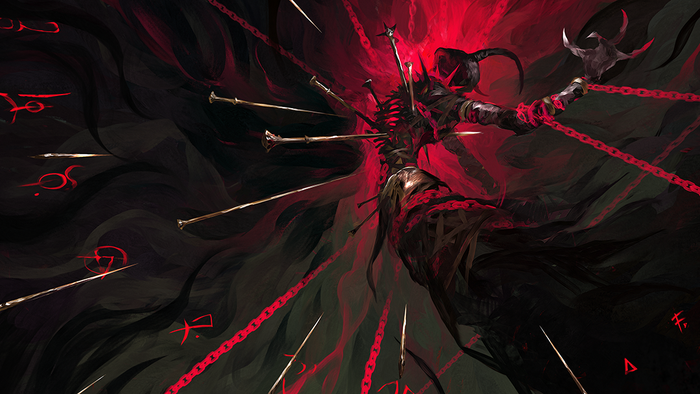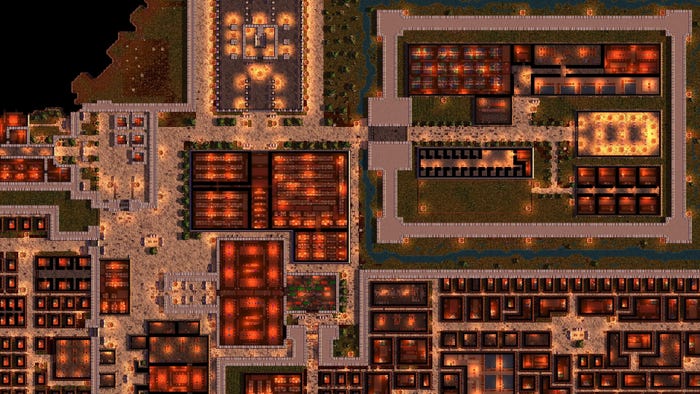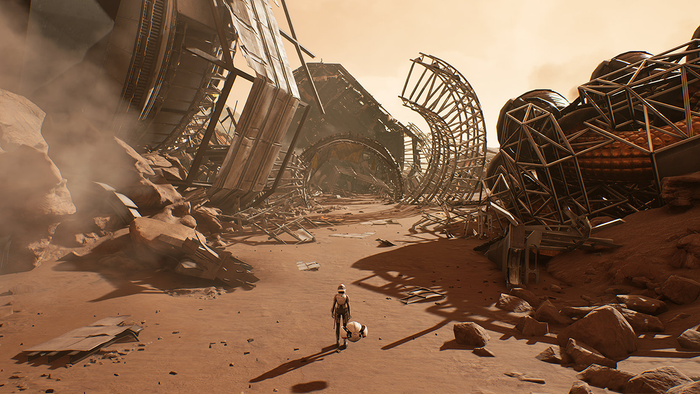Making of Super Mega Baseball No.17 - The F*#$ing Grind
The last 6 months before releasing Super Mega Baseball were a grind. The hours...the stress...the caffeine...the bug fixes...

This is the 17th post in a series about the making of our game, Super Mega Baseball (Polygon's 2014 Sports Game of the Year). It was copied over from our blog.
---
After the guys came back from GDC, they had a clear path to releasing Super Mega Baseball. They knew what had to be done, and what didn’t. And they were ready to get this thing released…no matter what it took.
Liane: You’re always referring to a period of time you call “the grind” – what was that?
Scott: That was our peak for hours worked.
Mike: You guys worked really hard before, like before that government funding application was submitted.
Scott: Yeah we did, we had a few of those shorter benders. But this was the most extensive.
Christian: Yeah, it was basically the entire period from after GDC until the game shipped. It was 7 days a week, 12 hours a day…minimum. That was the lower end of it.
Scott: Yeah, I think we’d usually take a half day on the weekend. But on weekdays, we’d literally work from when we woke up until we fell asleep.
Christian: In this time period we realized we were still quite a ways away from being shippable, but it was close enough that we could at least see a light at the end of the tunnel. But there was only so much energy remaining.
Scott: We could only sustain the hours we were working because we knew it was over soon.
Christian: Yeah, the end was in sight. There was a mountain of work between us and the end, but it was at least in sight.
Scott: I remember I’d go home, it might be 9pm at night, and I had one of our test PCs at home so I’d spend 3 hours at home doing balancing and a bit of bug fixing. Playing for 20 minutes at a time, then going back in and tweaking one of the variables, like difficulty or AI. I would work on regular work during the day and then at night it was just balancing and tweaking variables until I passed out.
Christian: Yeah, one of the more notable things from that period was that the last thought before I went to sleep was about work, and the very first thought when I woke up was about work. I was excited to come to work, but it was constant. I’d wake up and immediately be continuing the last thought I had before I fell asleep.
Liane: How long was the grind?
Christian: About 6 months.
Scott: It was unsustainable, and unhealthy. And I hope we don’t ever have to do it again. But it’s just what we needed to do to finish the f***ing game.
Liane: So during these last 6 months leading up to release, what kind of work was being done?
Christian: When we started this period, we had just hired QA help.
Andrew: One QA guy.
(Welcome Andrew to the conversation! Andrew joined the team during the grind to handle QA. We’ll be delving further into his role in our next blog post.)
Christian: The stuff that we had, it kind of worked but there were bugs and issues everywhere. There were hundreds and hundreds of usability and nitpick issues that Andrew found…like misaligned text, or features not working quite right. But those are things that you would expect to work on toward the end of a project like this, we had much more than that left. We had no platform integrations for massive systems, we had no save data system, we had no team development system, we had no character editing abilities. The game was still very, very unbalanced. The baseball simulation was not unfolding in any sort of realistic manner at all. PS3 performance was terrible, we didn’t fit into the PS3 memory, nor were we performant at all. So it was across the entire spectrum. There were very major chunks of the game that were nowhere near done at the beginning of the grind.
Scott: And we crammed everything in so late. If you went back even four weeks from release, if we would have shipped it at that date, it would have gotten a 40 Metacritic…or worse.
Mike: It wouldn’t have passed QA.
Scott: Right, it wouldn’t have made it through Sony's QA. It just didn’t work. There were many absolutely catastrophic problems right up until the very end. It was the most I’ve ever worked, but it was also really easy to stay in the zone because finally, after all this time, it was starting to come together. It was a dangerous cycle for our health, but man a lot of stuff came together quickly.
Andrew: What was the financial situation like?
Scott: Dire.
Christian: It was incredibly dire. It drove the release time as much as anything else. “Incredibly dire” is still painting a rosy picture on it.
Andrew: I was getting paid by the hour, I don’t know about you two.
Scott: We just weren’t getting paid.
Christian: You were the only one getting paid.
All: **Laughing**
Andrew: It’s kind of interesting. From the perspective of a guy who was just working 8 hours, I didn’t get the impression that you were dying zombies or anything. You seemed pretty normal to me. I knew you were working long hours but, hearing this now, I didn’t realize it was that bad.
Christian: Well that’s good.
Scott: We were under the stimulation of desperation.
Christian: When we say this thing was built with sweat and blood, it really was.
It was built with sweat and blood...and caffeine and beer. Here's an average grind day's beverage consumption:
Christian: The beverage consumption was totally absurd. Every day it was coffee at home, grab a gigantic coffee on the way to work, grab a coffee in the afternoon, go get a giant Monster Energy, drink beer, then another Monster at 1am after I had too much beer to even do mindless tasks. Those Monsters are filthy but they’re also incredibly effective, you are really effective until 3 in the morning. It’s magical. Absolutely magical.
Scott: Terrible stuff.
Admittedly, this photo of Christian is from long before the grind, but it pretty accurately reflects that time period...all but the hair:

Liane: What kind of testing did you do before release?
Christian: I think people would probably be pretty surprised to see how few actual players this game was exposed to before it shipped. It was basically Andrew that did the vast majority of the testing, then everyone else that worked on it, Scotty’s Dad, and a handful of our friends. But in total, the new player experience was somewhere in the order of like 15 to 20 people. That’s it. There were 20 people that played this thing and gave feedback on it before we shipped. It’s kind of crazy if you think about it.
Scott: I think it was at least twice a week at the end where we’d have people come into the office and we’d all watch that initial interaction with the game. And it was a nightmare at first... it was so frustrating because 15 minutes into these sessions we’d have an entire page of our notepad filled with problems, and that sucked. Oh god it sucked.
Mike: First-timers were so valuable.
Christian: We were worrying about all these things, and when you put somebody in front of it we’d realize that those things don’t matter, but they’d give us like 20 things that really do matter. It provided a lot of focus. And our friends were good sports, we bribed them all with beer.
Liane: Are there any examples that you remember?
Mike: I remember how many ways we were trying to show people that it’s their turn. In multiplayer, no one knew if they were fielding or pitching, or what was going on. So we had to figure out all the different ways we could tell people what they’re doing, and then test all of them.
Christian: And there was a lot of trying to balance the difficulty. We had brought in people with very different video game experience levels and we wanted to make sure that everyone could at least have some amount of fun with it. And when we first did it, the game was too hard. There were lots of people that were getting absolutely destroyed by the game, so we had to make it easier. And I’m really happy with where we ended up there.
Andrew: And on the flip side, the team development probably didn’t get any time with testers did it?
Christian: No. That was more or less tested by you.
Scott: And my Dad.
Christian: Yup.
Liane: Is there anything else from the grind that’s interesting?
Mike: I remember the Monkey was kind of interesting, that was the first time I’d used a tool like that - basically a tool that simulates random controller inputs and button presses. That thing found so many bugs.
Christian: We called it the Monkey because it kind of simulates what a monkey would do.
Mike: We just let it run for hours and hours and eventually it would crash the game. And I’d fix the bug and I’d let it run some more and it would find a different bug and I would fix that bug and I’d let it run some more, and I did this for weeks.
Scott: And only then could the game handle our drunk friends playing.
Mike: Yup. It was a great way to find really timing-specific bugs.
Scott: I remember another fun thing about that period, there was a second computer on the other desk and I would turn off the v-syncing and just let the game run at full speed. I would repeatedly let the AI play against itself, and then re-calibrate all the important variables of the game to get the stats to have the same kind of diversity as a real baseball game. It was very un-scientific, just staring at the AI and hand writing box scores of what happened each game, over and over again.
Christian: I remember one time period that was pure darkness, when the PS3 was supposed to run at 60 fps, and it didn’t. And it was not supposed to crash due to memory on PS3, and it did.
Mike: Yeah, I remember us going back to how much we could compress the animation.
Christian: Yeah. Oh yeah.
Mike: We went back to that many, many times.
Christian: There was one week, a 7-day period, where that’s all I did for 15 hours a day. Just trying to make the PS3 perform better. And every time it got a little better it was like a little bit of a victory.
Scott: And then a week later something would change and it would dip back to 30 fps again and the process would have to be repeated.
Mike: If you aren’t close to not running, then you’re not pushing the boundaries.
Christian: Yeah.
Liane: How do you feel about these 6 months?
Christian: In hindsight, it was a lot of work but this is one of the first blog posts where we can actually have a good time talking about it because it was actually getting done. A lot of the stuff in these blog posts so far was about throwing work out.
Scott: We didn’t throw anything out in this period of time.
Mike: It was the opposite of not throwing stuff out. It was more like the first version of everything that got done is what shipped.
All: **Laughing**
Mike: There was not a lot of iteration.
Scott: Yeah as soon as we deemed an issue with the game “not the worst problem” anymore, we stopped working on it. Often with intention to return to it, but we didn’t return to it. We just kept moving on to the next new problem until there didn’t seem to be any really bad problems.
Sounds like a rough 6 months… but as we know now, things panned out just fine. In the next post, we’ll take a closer look at QA and Andrew’s contribution to the game during this time.
---
This is the 17th post in a series about the making of our game, Super Mega Baseball (Polygon's 2014 Sports Game of the Year). It was copied over from our blog.
About the Author(s)
You May Also Like









